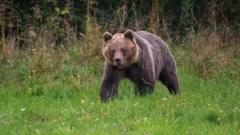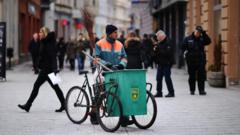After a man was killed by a bear in Central Slovakia, the government has enacted a controversial plan to cull a significant portion of the country's brown bear population. Critics, including conservationists, argue this decision undermines environmental obligations and fails to address the root cause of bear encounters.
Slovakia Approves Controversial Bear Cull Following Fatal Attack

Slovakia Approves Controversial Bear Cull Following Fatal Attack
The Slovak government has sanctioned the culling of 350 brown bears in response to a tragic mauling incident, igniting a debate between public safety and conservation.
The Slovak government has taken significant action in response to a tragic bear attack that resulted in the death of a 59-year-old man in Central Slovakia. Following an emergency cabinet meeting led by Prime Minister Robert Fico, the decision was made to cull approximately 350 brown bears, constituting nearly a quarter of the nation's estimated population of 1,300.
Citing public safety concerns linked to a rise in bear encounters, Prime Minister Fico emphasized the need for citizens to feel secure while venturing into the woods. “We can't live in a country where people are afraid to go into the woods,” he stated during a press conference.
The state of emergency, which permits the shooting of bears, has expanded to encompass 55 of Slovakia's 79 districts. Legal protections for the bears have already been relaxed, empowering authorities to eliminate bears that wander too close to human habitation. By the end of 2024, reports indicate that around 93 bears had already been killed under these revised regulations.
However, the government's aggressive culling strategy has attracted staunch criticism from conservationists. Notably, Michal Wiezek, an ecologist and member of the European Parliament for the opposition party Progressive Slovakia, labeled the decision as “absurd.” Wiezek accused the Environment Ministry of failing to mitigate bear attacks effectively and suggested that the government was attempting to cover up its shortcomings by initiating an even wider culling of a protected species.
Tragically, the recent fatal incident involved the victim being found in the woods near Detva, where authorities determined he sustained severe injuries consistent with a bear attack. Local NGOs reported that the area showed signs of a bear den, placing additional scrutiny on the interactions between humans and wildlife in the region.
The debate over bear management in Slovakia has intensified, especially in light of recent attacks, including another incident in March where a woman died after being pursued by a bear. The increasing visibility of bears in urban areas has further complicated the situation, leading to public outcry and heightened concern.
Environment Minister Tomas Taraba suggested that the bear population exceeds a sustainable number, asserting that about 800 bears would suffice for ecological balance. Nevertheless, experts contend that the population appears to stabilize around 1,270, emphasizing that significant human-bear interactions occur without violence.
As the culling initiative moves forward, the future of Slovakia's bear population remains uncertain, sparking discussions among citizens, environmentalists, and government officials alike.























